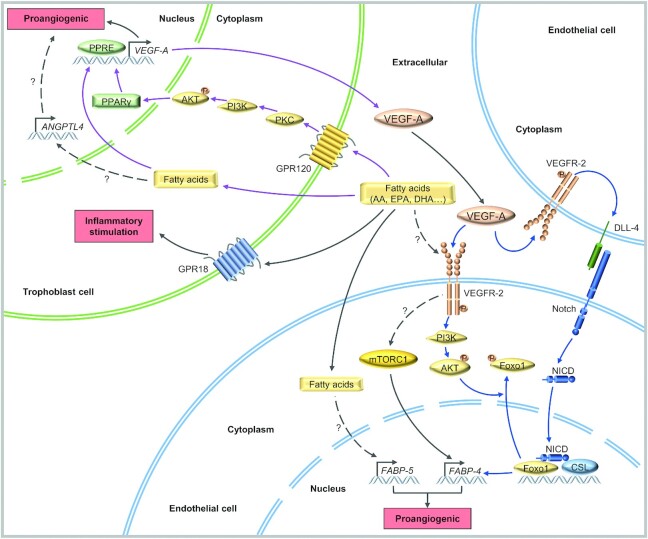FIGURE 3.
The proposed molecular mechanisms by which fatty acids regulate placental angiogenesis. Fatty acids, such as arachidonic acid (AA), EPA, and DHA, activate G-protein coupled receptor 120 (GPR120) on trophoblasts, thereby inducing activation of the PI3K/AKT signaling pathway. In the downstream cascade, the binding of peroxisome proliferator-activated receptor γ (PPARγ) to the PPAR-response element (PPRE) in the vascular endothelial growth factor-A (VEGF-A) promoter region is specifically enhanced (purple arrow). Note that fatty acids can directly activate PPARγ to enhance the transcription and release of VEGF-A. VEGF-A induces the expression of fatty acid-binding protein 4 (FABP-4) through delta-like ligand 4 (DLL-4)-Notch signal transduction between endothelial cells and is negatively regulated by forkhead box protein O1 (Foxo1) phosphorylation and cytoplasmic translocation induced by AKT activation (blue arrow). Additionally, fatty acids activate the GPR18 and mammalian target of rapamycin complex 1 (mTORC1) and regulate the expression of angiopoietin-like 4 (ANGPTL4) and FABP-5, which may also affect placental angiogenesis, although their exact molecular mechanisms have not been determined. AKT, V-Akt Murine Thymoma Viral Oncogene Homolog; CSL, CBFl/Suppressor of Hairless/Lag-1; NICD, Notch intracellular domain; PI3K, phosphatidylinositol-3-kinase; PKC, protein kinase C. Dashed arrows indicate hypothetical relations not studied directly.

